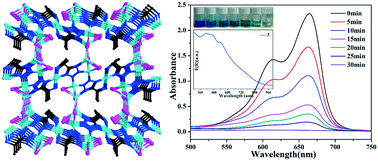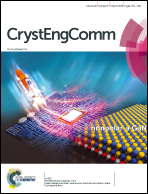Syntheses of copper–iodine cluster-based frameworks for photocatalytic degradation of methylene blue†
Abstract
Two new copper–iodine cluster-based frameworks, namely, {Cu4I4[Cu(5-eatz)2]2}n (1; 5-eatzH = (1S)-1-(5-tetrazolyl)ethylamine) and {Cu4I4Cu(5-eatz)2}n (2), are synthesized. For comparison purposes, the compound {2[N(CH3)4]+·Cu12I12[CuI(5-eatz)2]2}n (3) reported by us is also included. These compounds have similar porphyrin-like Cu(5-eatz)2 units but different Cu–I sub-structures, for example, the discrete Cu4I4 unit in 1, the 1D Cu–I graphene-like nanoribbon in 2 and the 3D Cu–I framework in 3, which can be obtained under tunable synthesis conditions. These structure features lead to the deep color appearance of crystals and strong adsorption in the visible light region. The diffuse reflectance spectra show that compounds 1 and 2 exhibit very low Eg values, which are equal to 1.18 eV for 1 and 1.12 eV for 2. Interestingly, all of them exhibit excellent intrinsic photocatalytic activity to degrade methylene blue (MB) under visible light. 2 shows better photocatalytic performance than 1 and 3, and can almost completely degrade MB in 300 minutes (with a degradation amount of 90%) without any sacrificial agents. Meanwhile, their photocatalytic activities are in the order 3 < 1 < 2, which is opposite that of their Eg (3 > 1 > 2) values (Eg3 = 1.49 eV). Remarkably, all of 1, 2 and 3 can completely photodegrade the MB solution in 30 minutes in the presence of H2O2. The results demonstrate the potential application of copper–iodine cluster-based frameworks for the photocatalytic degradation of organic dyes.

- This article is part of the themed collection: Crystalline Materials for Environmental Remediation


 Please wait while we load your content...
Please wait while we load your content...